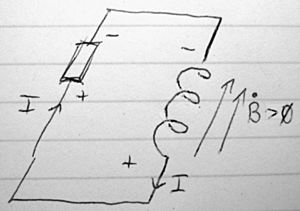Lenz's law facts for kids
Lenz's law is a key idea in electromagnetism. It helps us understand how electrical circuits follow important rules like Newton's third law (for every action, there's an equal and opposite reaction) and the conservation of energy. This law is named after Emil Lenz, a scientist who studied these effects.
Simply put, Lenz's law tells us that when a magnetic field changes near a wire, it creates an electric current. This new current then makes its own magnetic field, and this new field always tries to work against the original change that created it. It's like nature trying to keep things balanced!
Lenz's law is shown by the minus sign in Faraday's law of induction, which is a famous equation in physics:
This minus sign means that the "electrical push" (called an induced electromotive force or emf) and the change in the magnetic field (magnetic flux) are always in opposite directions.
Contents
How Lenz's Law Works
Imagine you have a loop of wire, and a magnet is moving near it. As the magnet moves, the amount of magnetic field passing through the loop changes. This change creates an electric current in the wire loop.
Lenz's law tells us the direction of this new current. The current will flow in a way that creates its own magnetic field, and this new field will try to stop the original change from happening.
For example, if you push a magnet's north pole towards a coil of wire, the coil will create a current. This current will make the side of the coil facing the magnet act like a north pole too. Since two north poles repel each other, the coil's magnetic field pushes back against the incoming magnet. This push opposes the motion that caused the current in the first place.
Similarly, if you pull the magnet away, the coil will create a current that makes its side act like a south pole. This south pole will try to pull the magnet back, again opposing the change.
Why Lenz's Law is Important
Lenz's law is very important because it helps us understand many everyday technologies. It explains how inductors work, which are components used in electronic circuits. It also helps explain how generators create electricity and how motors work.
When you turn on a light switch, the current in the wires doesn't instantly jump to full power. Lenz's law explains why. As the current starts to flow, it creates a changing magnetic field around the wires. This changing field then creates a "back emf" or "back voltage" that tries to stop the current from building up too quickly. This is why you sometimes see a small spark when you open a switch slowly – the circuit is trying to keep the current flowing.
Lenz's Law and Energy Conservation
One of the most amazing things about Lenz's law is that it helps keep the conservation of energy principle true. The law of conservation of energy says that energy cannot be created or destroyed, only changed from one form to another.
If Lenz's law didn't exist, imagine what would happen: If you moved a magnet towards a coil, and the induced current's magnetic field helped the magnet move instead of opposing it, the magnet would speed up on its own. This would create more current, which would make the magnet move even faster, and so on, forever! This would mean we'd be creating energy out of nothing, which is impossible according to the law of conservation of energy.
So, Lenz's law ensures that to create an electric current, you always have to do some work against the opposing magnetic force. This work is then converted into electrical energy, keeping the total energy balanced.
Images for kids
-
Lenz's law tells the direction of a current in a conductor loop induced indirectly by the change in magnetic flux through the loop. Scenarios a, b, c, d and e are possible. Scenario f is impossible due to the law of conservation of energy. The charges (electrons) in the conductor are not pushed in motion directly by the change in flux, but by a circular electric field (not pictured) surrounding the total magnetic field of inducing and induced magnetic fields. This total magnetic field induces the electric field.
See also
 In Spanish: Ley de Lenz para niños
In Spanish: Ley de Lenz para niños




